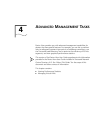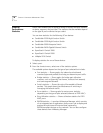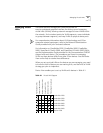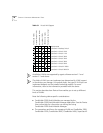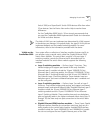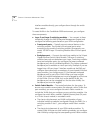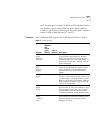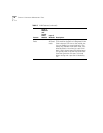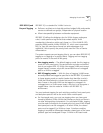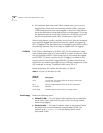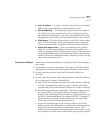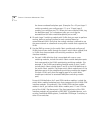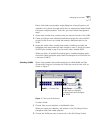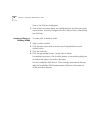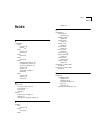
Managing Virtual LANs 45
IEEE 802.1Q and
Per-port Tagging
IEEE 802.1Q is a standard for VLANs. It aims to:
■ Define an architecture to logically partition bridged LANs and provide
services to defined user groups, independent of physical location
■ Allow interoperability between multivendor equipment.
IEEE 802.1Q defines the bridging rules for VLANs (ingress and egress
rules). It also specifies a tag format that embeds explicit VLAN
membership information within each frame in a 12-bit VLAN ID (VID),
providing 4094 possible VLANs. IEEE 802.1D, which now incorporates
802.1p, uses this same frame format but takes advantage of an
additional 3 bits to specify the priority levels used for Class of Service
differentiation.
The system supports per-port tagging (that is, you can select IEEE 802.1Q
tagging or no tagging on a per-port basis). Tagging and non-tagging
ports can coexist in the same VLAN group.
■
Non-tagging mode
— The default tagging mode. Use this tagging
mode for front-panel ports if the environment includes end stations
that do not support 802.1Q VLANs. Non-tagged VLAN ports accept
tagged frames; however, any traffic transmitted from an untagged
port on a VLAN is untagged.
■
802.1Q tagging mode
— With this form of tagging, VLAN frames
are encapsulated and tagged as specified in the IEEE 802.1Q standard.
In frame tagging mode, an explicit header that identifies to which
VLAN the frame belongs is inserted into each frame of interswitch
data. Frames in the same VLAN can be tagged or untagged. An
untagged port in a VLAN cannot insert a tag, but it can recognize a
tagged frame. Use this mode for VLANs in an IEEE 802.1Q
environment.
You must evaluate tagging for each switching module’s front-panel ports
and backplane ports as well as the switch fabric module ports:
■
For front-panel ports, you must use tagging when you have ports
shared by different VLANs (VLANs that overlap on ports) and there is
no other distinguishing characteristic. For port-based VLANs, tagging
must be used to distinguish the shared ports (only one VLAN’s shared
front-panel ports can be untagged; in all other VLANs, the shared
ports must be tagged). For VLANs on Layer 3 interface modules,
tagging is required to differentiate between shared ports of the same
protocol type and overlapped IP Layer 3 VLANs in allClosed mode.



